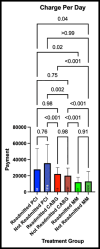Treatment charges for acute coronary syndrome: A retrospective analysis
- PMID: 40821465
- PMCID: PMC12351736
- DOI: 10.1080/08998280.2025.2530809
Treatment charges for acute coronary syndrome: A retrospective analysis
Abstract
Background: This study analyzes the costs associated with treatment strategies for acute coronary syndrome: coronary artery bypass grafting (CABG), percutaneous coronary intervention (PCI), and medical management (MM).
Methods: This is a substudy of a previous analysis showing improved outcomes with CABG compared to PCI and MM, now focusing on variation in charges based on the type of treatment, hospital length of stay (LOS), and the occurrence of hospital readmission. We extracted total reimbursements, LOS, and readmissions for acute coronary syndrome patients (4267) between 2018 and 2022 from the electronic health record.
Results: Expenses related to total charges were higher for CABG patients than PCI patients (+$106,047); however, average daily charges were lower for CABG patients compared to PCI patients (+$14,957). LOS was a primary driver for total charges, as CABG patients stayed 8.35 ± 0.50 days longer than PCI patients on average. The average difference between the total charge amount for readmitted and nonreadmitted patients was $22,765 ± $11,820. Even though readmission increases total charges, the charge per day was still less in patients with readmission due to their longer LOS.
Conclusion: The higher total charge amount and lower charge per day in CABG patients compared to PCI patients, as well as readmitted patients, highlights the importance of employing strategies to reduce LOS and minimize charges for CABG and readmissions.
Keywords: Acute coronary syndrome; cost analysis; hospital length of stay; multivessel coronary artery disease; readmission.
Copyright © 2025 Baylor University Medical Center.
Conflict of interest statement
The authors gratefully acknowledge funding support from the Cardiovascular Research Review Committee at Baylor Scott & White Research Institute. Dr. Widmer declares industry relationships with Philips, Medtronic, and Abbott. The other authors report no potential conflicts of interest.
Figures



Similar articles
-
Intravenous magnesium sulphate and sotalol for prevention of atrial fibrillation after coronary artery bypass surgery: a systematic review and economic evaluation.Health Technol Assess. 2008 Jun;12(28):iii-iv, ix-95. doi: 10.3310/hta12280. Health Technol Assess. 2008. PMID: 18547499
-
Mortality after coronary artery bypass grafting versus percutaneous coronary intervention with stenting for coronary artery disease: a pooled analysis of individual patient data.Lancet. 2018 Mar 10;391(10124):939-948. doi: 10.1016/S0140-6736(18)30423-9. Epub 2018 Feb 23. Lancet. 2018. PMID: 29478841
-
Preoperative coronary interventions for preventing acute myocardial infarction in the perioperative period of major open vascular or endovascular surgery.Cochrane Database Syst Rev. 2024 Jul 3;7(7):CD014920. doi: 10.1002/14651858.CD014920.pub2. Cochrane Database Syst Rev. 2024. PMID: 38958136 Free PMC article.
-
Prescription of Controlled Substances: Benefits and Risks.2025 Jul 6. In: StatPearls [Internet]. Treasure Island (FL): StatPearls Publishing; 2025 Jan–. 2025 Jul 6. In: StatPearls [Internet]. Treasure Island (FL): StatPearls Publishing; 2025 Jan–. PMID: 30726003 Free Books & Documents.
-
Early readmissions after percutaneous mechanical circulatory support-assisted percutaneous coronary intervention: Insights from the nationwide readmissions database.Cardiovasc Revasc Med. 2025 Jun 13:S1553-8389(25)00287-8. doi: 10.1016/j.carrev.2025.06.002. Online ahead of print. Cardiovasc Revasc Med. 2025. PMID: 40533365
References
-
- Switaj TL, Christensen SR, Brewer DM.. Acute coronary syndrome: current treatment. Am Fam Physician. 2017;95(4):232–240. - PubMed
LinkOut - more resources
Full Text Sources
Miscellaneous
